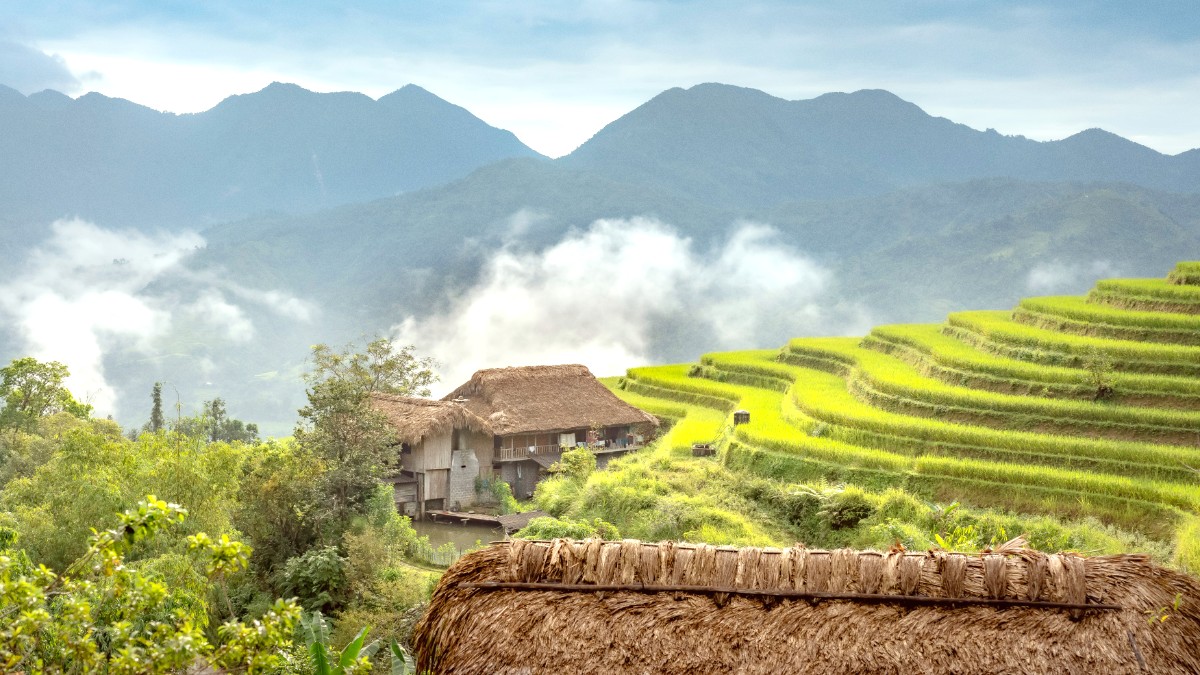
Northwest Vietnam, Vietnam
The culinary foundation rests on sticky rice (xôi nếp nương), fresh river fish, various bamboo shoots, wild vegetables, and locally raised chicken and pork. Common herbs include lemongrass, ginger, chili, and garlic.
Flavors tend to be savory, sometimes with a spicy kick, and often balance sweet and sour notes.
Cuisine remains consistent across the Mai Chau valley, centered on traditional White Thai dishes. Similar offerings exist in Lac, Poom Coong, and the town area.
Meals generally follow standard times for breakfast, lunch, and dinner. Many homestays offer all-inclusive meal plans, providing convenient and authentic dining.
When drinking with locals, especially local rice wine, a common toast is "Chúc sức khỏe" (chew-sook-kweh), meaning "cheers to your health."
Glutinous rice often cooks inside bamboo tubes, infusing an earthy aroma. A staple, accompanying various main dishes.
Widely available at homestays and local eateries.
Local free-range chicken, marinated with regional herbs and spices (lemongrass, chili, honey), then grilled whole over charcoal.
Most homestays and local restaurants offer this.
Pork from a specific local breed, known for its lean meat and distinct flavor. Often grilled or stir-fried.
A robust and satisfying dish.
Less prevalent than in major cities. You might find local snacks, grilled skewers, or simple noodle dishes near markets.
Trà xanh (Green Tea) served commonly after meals. Rượu cần is the signature alcoholic beverage. Local Vietnamese beers like Bia Hanoi and Bia Saigon are widely available.
No fine dining restaurants in the urban sense. The highest-end dining experiences exist within resorts like Mai Chau Ecolodge, which provide refined atmosphere and curated menus.
Several local restaurants are available, especially in Lac and Poom Coong villages. These establishments offer local dishes at reasonable prices, providing comfortable dining.
Homestays are typically the best budget option for meals, as many include food in their accommodation package. Small local eateries (quán ăn) offer very affordable and authentic Vietnamese meals.
Dining experiences mirror the rural, community-focused nature of Mai Chau. Expect genuine Vietnamese and White Thai ethnic cuisine.
Look for places popular with locals for the most authentic experience.
The Mai Chau town market provides an opportunity to see local life and ingredients. No dedicated food halls exist.
A chance to purchase fresh ingredients if self-catering.
Often included, a cost-effective and culturally immersive choice.
Known as quán ăn, very affordable and popular with residents.
Available at eco-lodges for a more Westernized or luxurious meal.
Fresh produce and some ready-to-eat local snacks.
Navigating can be challenging due to language barriers and common ingredients (soy sauce, fish sauce).
An app like "LingoCard" or Google Translate may assist.
Your homestay host is a good resource. Inform them of your needs in advance; they often prepare suitable meals or guide you to eateries.
Direct communication is for safe dining.
In local kitchens, cross-contamination is a possibility due to shared cooking surfaces and utensils, especially for severe allergies.
Local cooking relies on fresh, whole ingredients. However, sauces and marinades can contain hidden allergens.
Some homestays or eco-lodges offer cooking classes on local White Thai cuisine. Learn to prepare sticky rice or grilled chicken.
Mai Chau does not host major food festivals. Minor local celebrations might involve special food preparations, offering a glimpse into culinary traditions.
Inquire at homestays about witnessing the traditional process of making Rượu cần (rice wine). Some hosts may share the techniques.
A chance to sample freshly made local spirits.
Depending on the season, you might join locals in harvesting fruits or vegetables from their gardens, a very hands-on food experience.
Directly taste farm-fresh produce.
Dining at homestays and local eateries directly benefits the Mai Chau community.
Language barriers exist, especially outside tourist villages. Simple phrases or translation apps are helpful.
Embrace the local pace and dining customs for a rewarding culinary journey.
While food in homestays is typically prepared fresh, consume only bottled water. Avoid ice in drinks unless certain of its source. Eat at places with visible local patronage.